Development of pH-Indicative and Antimicrobial Films Based on Polyvinyl Alcohol/Starch Incorporated with Ethyl Lauroyl Arginate and Mulberry Anthocyanin for Active Packaging
Abstract
1. Introduction
2. Materials and Methods
2.1. Materials
2.2. Preparation of PVA/Starch/LAE/Mulberry Anthocyanin Films
2.3. Characterization of the PVA/Starch/LAE/Mulberry Anthocyanin Films
2.3.1. Scanning Electron Microscopy (SEM)
2.3.2. Fourier Transform Infrared (FTIR) Spectroscopy
2.3.3. X-ray Diffraction (XRD)
2.3.4. Thickness and Mechanical Properties
2.3.5. UV Barrier and Light Transmittance
2.3.6. Water Vapor Permeability (WVP) and Moisture Absorption (MA)
2.3.7. Color Indication of Anthocyanin and Blend Films
2.3.8. In Vitro Antimicrobial Activity
2.3.9. Milk Spoilage Test
2.3.10. Statistical Analysis
3. Results
3.1. Morphology
3.2. FTIR Analysis
3.3. XRD Analysis
3.4. Thickness and Mechanical Performance
3.5. UV-Vis-Light Barrier Properties and Opacity Analysis
3.6. Water Vapor Permeability (WVP) and Moisture Absorption (MA) Analysis
3.7. In Vitro Antimicrobial Activity
3.8. Color Analysis of Mulberry Anthocyanin and the Blend Films
3.9. Milk Spoilage Test of Active Films
4. Conclusions
Author Contributions
Funding
Institutional Review Board Statement
Informed Consent Statement
Data Availability Statement
Conflicts of Interest
References
- Törrönen, R.; Määttä, K. Bioactive substances and health benefits of strawberries. In Proceedings of the IV International Strawberry Symposium 567, Tampere, Finland, 21–24 September 2000; pp. 797–803. [Google Scholar]
- Yao, X.; Qin, Y.; Zhang, M.; Zhang, J.; Qian, C.; Liu, J. Development of active and smart packaging films based on starch, polyvinyl alcohol and betacyanins from different plant sources. Int. J. Biol. Macromol. 2021, 183, 358–368. [Google Scholar] [CrossRef] [PubMed]
- Anghel, N.; Dinu, M.V.; Zaltariov, M.; Pamfil, D.; Spiridon, I. New cellulose-collagen-alginate materials incorporated with quercetin, anthocyanins and lipoic acid. Int. J. Biol. Macromol. 2021, 181, 30–40. [Google Scholar] [CrossRef] [PubMed]
- Haghighi, H.; De Leo, R.; Bedin, E.; Pfeifer, F.; Siesler, H.W.; Pulvirenti, A. Comparative analysis of blend and bilayer films based on chitosan and gelatin enriched with LAE (lauroyl arginate ethyl) with antimicrobial activity for food packaging applications. Food Packag. Shelf Life 2019, 19, 31–39. [Google Scholar] [CrossRef]
- Liao, J.; Li, J.; Yang, F.; Zhu, Y.; Wang, H.; Du, G.; Essawy, H.; Zhou, X. Assisted Compatibility, and Balanced Regulation of the Mechanical, Thermal, and Antioxidant Activity of Polyvinyl Alcohol-Chinese Bayberry Tannin Extract Films Using Different Di-Aldehydes as Cross-Linkers. J. Renew. Mater. 2022, 10, 359. [Google Scholar] [CrossRef]
- Helmiyati, H.; Hidayat, Z.S.Z.; Sitanggang, I.F.R.; Liftyawati, D. Antimicrobial packaging of ZnO–Nps infused into CMC–PVA nanocomposite films effectively enhances the physicochemical properties. Polymer Test. 2021, 104, 107412. [Google Scholar] [CrossRef]
- Aslam, M.; Kalyar, M.A.; Raza, Z.A. Polyvinyl alcohol: A review of research status and use of polyvinyl alcohol based nanocomposites. Polymer Eng. Sci. 2018, 58, 2119–2132. [Google Scholar] [CrossRef]
- Halima, N.B. Poly (vinyl alcohol): Review of its promising applications and insights into biodegradation. RSC Adv. 2016, 6, 39823–39832. [Google Scholar] [CrossRef]
- Jayakumar, A.; Heera, K.; Sumi, T.; Joseph, M.; Mathew, S.; Praveen, G.; Nair, I.C.; Radhakrishnan, E. Starch-PVA composite films with zinc-oxide nanoparticles and phytochemicals as intelligent pH sensing wraps for food packaging application. Int. J. Biol. Macromol. 2019, 136, 395–403. [Google Scholar] [CrossRef]
- Wu, F.; Zhou, Z.; Li, N.; Chen, Y.; Zhong, L.; Law, W.C.; Tang, C.Y. Development of poly (vinyl alcohol)/starch/ethyl lauroyl arginate blend films with enhanced antimicrobial and physical properties for active packaging. Int. J. Biol. Macromol. 2021, 192, 389–397. [Google Scholar] [CrossRef]
- Singha, A.S.; Priya, B.; Pathania, D. Cornstarch/poly (vinyl alcohol) biocomposite blend films: Mechanical properties, thermal behavior, fire retardancy, and antibacterial activity. Int. J. Polym. Anal. Charact. 2015, 20, 357–366. [Google Scholar] [CrossRef]
- Garavand, Y.; Taheri-Garavand, A.; Garavand, F.; Shahbazi, F.; Khodaei, D.; Cacciotti, I. Starch-Polyvinyl Alcohol-Based Films Reinforced with Chitosan Nanoparticles: Physical, Mechanical, Structural, Thermal and Antimicrobial Properties. Appl. Sci. 2022, 12, 1111. [Google Scholar] [CrossRef]
- Menzel, C.; González-Martínez, C.; Chiralt, A.; Vilaplana, F. Antioxidant starch films containing sunflower hull extracts. Carbohydr. Polym. 2019, 214, 142–151. [Google Scholar] [CrossRef]
- Yun, D.; Cai, H.; Liu, Y.; Xiao, L.; Song, J.; Liu, J. Development of active and intelligent films based on cassava starch and Chinese bayberry (Myrica rubra Sieb. et Zucc.) anthocyanins. RSC Adv. 2019, 9, 30905–30916. [Google Scholar] [CrossRef]
- Zhou, S.; Zhai, X.; Zhang, R.; Wang, W.; Lim, L.-T.; Hou, H. High-Throughput Fabrication of Antibacterial Starch/PBAT/AgNPs@ SiO2 Films for Food Packaging. Nanomaterials 2021, 11, 3062. [Google Scholar] [CrossRef] [PubMed]
- Demircan, B.; Özdestan-Ocak, Ö. Effects of lemon essential oil and ethyl lauroyl arginate on the physico-chemical and mechanical properties of chitosan films for mackerel fillet coating application. J. Food Measur. Charact. 2021, 15, 1499–1508. [Google Scholar] [CrossRef]
- Rubilar, J.F.; Candia, D.; Cobos, A.; Díaz, O.; Pedreschi, F. Effect of nanoclay and ethyl-Nα-dodecanoyl-l-arginate hydrochloride (LAE) on physico-mechanical properties of chitosan films. LWT-Food Sci. Technol. 2016, 72, 206–214. [Google Scholar] [CrossRef]
- Higueras, L.; López-Carballo, G.; Hernández-Muñoz, P.; Gavara, R.; Rollini, M. Development of a novel antimicrobial film based on chitosan with LAE (ethyl-Nα-dodecanoyl-l-arginate) and its application to fresh chicken. Int. J. Food Microbiol. 2013, 165, 339–345. [Google Scholar] [CrossRef]
- Becerril, R.; Manso, S.; Nerin, C.; Gómez-Lus, R. Antimicrobial activity of Lauroyl Arginate Ethyl (LAE), against selected food-borne bacteria. Food Control 2013, 32, 404–408. [Google Scholar] [CrossRef]
- Saldana, G.; Puertolas, E.; Monfort, S.; Raso, J.; Alvarez, I. Defining treatment conditions for pulsed electric field pasteurization of apple juice. Int. J. Food Microbiol. 2011, 151, 29–35. [Google Scholar] [CrossRef]
- Woodcock, N.; Hammond, B.; Ralyea, R.; Boor, K. Nα-Lauroyl-l-arginine ethylester monohydrochloride reduces bacterial growth in pasteurized milk. J. Dairy Sci. 2009, 92, 4207–4210. [Google Scholar] [CrossRef]
- Manso, S.; Wrona, M.; Salafranca, J.; Nerín, C.; Alfonso, M.J.; Caballero, M.Á. Evaluation of New Antimicrobial Materials Incorporating Ethyl Lauroyl Arginate or Silver into Different Matrices, and Their Safety in Use as Potential Packaging. Polymers 2021, 13, 355. [Google Scholar] [CrossRef] [PubMed]
- Nerin, C.; Becerril, R.; Manso, S.; Silva, F. Ethyl lauroyl arginate (LAE): Antimicrobial activity and applications in food systems. In Antimicrobial Food Packaging; Elsevier: Amsterdam, The Netherlands, 2016; pp. 305–312. [Google Scholar]
- Theinsathid, P.; Visessanguan, W.; Kruenate, J.; Kingcha, Y.; Keeratipibul, S. Antimicrobial activity of lauric arginate-coated polylactic acid films against Listeria monocytogenes and Salmonella typhimurium on cooked sliced ham. J. Food Sci. 2012, 77, M142–M149. [Google Scholar] [CrossRef] [PubMed]
- Haghighi, H.; Leugoue, S.K.; Pfeifer, F.; Siesler, H.W.; Licciardello, F.; Fava, P.; Pulvirenti, A. Development of antimicrobial films based on chitosan-polyvinyl alcohol blend enriched with ethyl lauroyl arginate (LAE) for food packaging applications. Food Hydrocoll. 2020, 100, 105419. [Google Scholar] [CrossRef]
- Qin, Y.; Yun, D.; Xu, F.; Chen, D.; Kan, J.; Liu, J. Smart packaging films based on starch/polyvinyl alcohol and Lycium ruthenicum anthocyanins-loaded nano-complexes: Functionality, stability and application. Food Hydrocoll. 2021, 119, 106850. [Google Scholar] [CrossRef]
- Yousuf, B.; Gul, K.; Wani, A.A.; Singh, P. Health benefits of anthocyanins and their encapsulation for potential use in food systems: A review. Crit. Rev. Food Sci. Nutr. 2016, 56, 2223–2230. [Google Scholar] [CrossRef]
- Roy, S.; Kim, H.-J.; Rhim, J.-W. Effect of blended colorants of anthocyanin and shikonin on carboxymethyl cellulose/agar-based smart packaging film. Int. J. Biol. Macromol. 2021, 183, 305–315. [Google Scholar] [CrossRef]
- Chen, H.-Z.; Zhang, M.; Bhandari, B.; Yang, C.-H. Novel pH-sensitive films containing curcumin and anthocyanins to monitor fish freshness. Food Hydrocoll. 2020, 100, 105438. [Google Scholar] [CrossRef]
- Luchese, C.L.; Abdalla, V.F.; Spada, J.C.; Tessaro, I.C. Evaluation of blueberry residue incorporated cassava starch film as pH indicator in different simulants and foodstuffs. Food Hydrocoll. 2018, 82, 209–218. [Google Scholar] [CrossRef]
- Qin, Y.; Xu, F.; Yuan, L.; Hu, H.; Yao, X.; Liu, J. Comparison of the physical and functional properties of starch/polyvinyl alcohol films containing anthocyanins and/or betacyanins. Int. J. Biol. Macromol. 2020, 163, 898–909. [Google Scholar] [CrossRef]
- Jiang, G.; Hou, X.; Zeng, X.; Zhang, C.; Wu, H.; Shen, G.; Li, S.; Luo, Q.; Li, M.; Liu, X. Preparation and characterization of indicator films from carboxymethyl-cellulose/starch and purple sweet potato (Ipomoea batatas (L.) lam) anthocyanins for monitoring fish freshness. Int. J. Biol. Macromol. 2020, 143, 359–372. [Google Scholar] [CrossRef]
- Liu, P.; Wang, R.; Kang, X.; Cui, B.; Yu, B. Effects of ultrasonic treatment on amylose-lipid complex formation and properties of sweet potato starch-based films. Ultrason. Sonochem. 2018, 44, 215–222. [Google Scholar]
- Zhang, K.; Huang, T.-S.; Yan, H.; Hu, X.; Ren, T. Novel pH-sensitive films based on starch/polyvinyl alcohol and food anthocyanins as a visual indicator of shrimp deterioration. Int. J. Biol. Macromol. 2020, 145, 768–776. [Google Scholar] [CrossRef]
- Abral, H.; Basri, A.; Muhammad, F.; Fernando, Y.; Hafizulhaq, F.; Mahardika, M.; Sugiarti, E.; Sapuan, S.; Ilyas, R.; Stephane, I. A simple method for improving the properties of the sago starch films prepared by using ultrasonication treatment. Food Hydrocoll. 2019, 93, 276–283. [Google Scholar]
- Zhai, X.; Shi, J.; Zou, X.; Wang, S.; Jiang, C.; Zhang, J.; Huang, X.; Zhang, W.; Holmes, M. Novel colorimetric films based on starch/polyvinyl alcohol incorporated with roselle anthocyanins for fish freshness monitoring. Food Hydrocoll. 2017, 69, 308–317. [Google Scholar] [CrossRef]
- Qin, Y.; Liu, Y.; Yong, H.; Liu, J.; Zhang, X.; Liu, J. Preparation and characterization of active and intelligent packaging films based on cassava starch and anthocyanins from Lycium ruthenicum Murr. Int. J. Biol. Macromol. 2019, 134, 80–90. [Google Scholar] [CrossRef]
- Wu, F.; Zhou, Z.; Liang, M.; Zhong, L.; Xie, F. Ultrasonication improves the structures and physicochemical properties of cassava starch films containing acetic acid. Starch-Stärke 2021, 73, 2000094. [Google Scholar] [CrossRef]
- Sohany, M.; Tawakkal, I.S.M.A.; Ariffin, S.H.; Shah, N.N.A.K.; Yusof, Y.A. Characterization of anthocyanin associated purple sweet potato starch and peel-based pH indicator films. Foods 2021, 10, 2005. [Google Scholar] [CrossRef]
- Mali, S.; Grossmann, M.V.E.; García, M.A.; Martino, M.N.; Zaritzky, N.E. Effects of controlled storage on thermal, mechanical and barrier properties of plasticized films from different starch sources. J. Food Eng. 2006, 75, 453–460. [Google Scholar] [CrossRef]
- Wu, J.; Sun, X.; Guo, X.; Ge, S.; Zhang, Q. Physicochemical properties, antimicrobial activity and oil release of fish gelatin films incorporated with cinnamon essential oil. Aquac. Fish. 2017, 2, 185–192. [Google Scholar] [CrossRef]
- Hajji, S.; Chaker, A.; Jridi, M.; Maalej, H.; Jellouli, K.; Boufi, S.; Nasri, M. Structural analysis, and antioxidant and antibacterial properties of chitosan-poly (vinyl alcohol) biodegradable films. Environ. Sci. Pollut. Res. 2016, 23, 15310–15320. [Google Scholar] [CrossRef]
- Sugumaran, S.; Bellan, C. Transparent nano composite PVA–TiO2 and PMMA–TiO2 thin films: Optical and dielectric properties. Optik 2014, 125, 5128–5133. [Google Scholar] [CrossRef]
- Bertuzzi, M.A.; Vidaurre, E.C.; Armada, M.; Gottifredi, J. Water vapor permeability of edible starch based films. J. Food Eng. 2007, 80, 972–978. [Google Scholar] [CrossRef]
- Wang, X.; Yong, H.; Gao, L.; Li, L.; Jin, M.; Liu, J. Preparation and characterization of antioxidant and pH-sensitive films based on chitosan and black soybean seed coat extract. Food Hydrocoll. 2019, 89, 56–66. [Google Scholar] [CrossRef]
- Chen, H.; Yu, W.; Chen, G.; Meng, S.; Xiang, Z.; He, N. Antinociceptive and antibacterial properties of anthocyanins and flavonols from fruits of black and non-black mulberries. Molecules 2017, 23, 4. [Google Scholar] [CrossRef]
- Matsufuji, H.; Kido, H.; Misawa, H.; Yaguchi, J.; Otsuki, T.; Chino, M.; Takeda, M.; Yamagata, K. Stability to light, heat, and hydrogen peroxide at different pH values and DPPH radical scavenging activity of acylated anthocyanins from red radish extract. J. Agric. Food Chem. 2007, 55, 3692–3701. [Google Scholar] [CrossRef]
- Özkan, M.; Yemenicioglu, A.; Asefi, N.; Cemeroglu, B. Degradation kinetics of anthocyanins from sour cherry, pomegranate, and strawberry juices by hydrogen peroxide. J. Food Sci. 2002, 67, 525–529. [Google Scholar] [CrossRef]
- Cevallos-Casals, B.A.; Cisneros-Zevallos, L. Stability of anthocyanin-based aqueous extracts of Andean purple corn and red-fleshed sweet potato compared to synthetic and natural colorants. Food Chem. 2004, 86, 69–77. [Google Scholar] [CrossRef]
- Pourjavaher, S.; Almasi, H.; Meshkini, S.; Pirsa, S.; Parandi, E. Development of a colorimetric pH indicator based on bacterial cellulose nanofibers and red cabbage (Brassica oleraceae) extract. Carbohydr. Polym. 2017, 156, 193–201. [Google Scholar] [CrossRef]
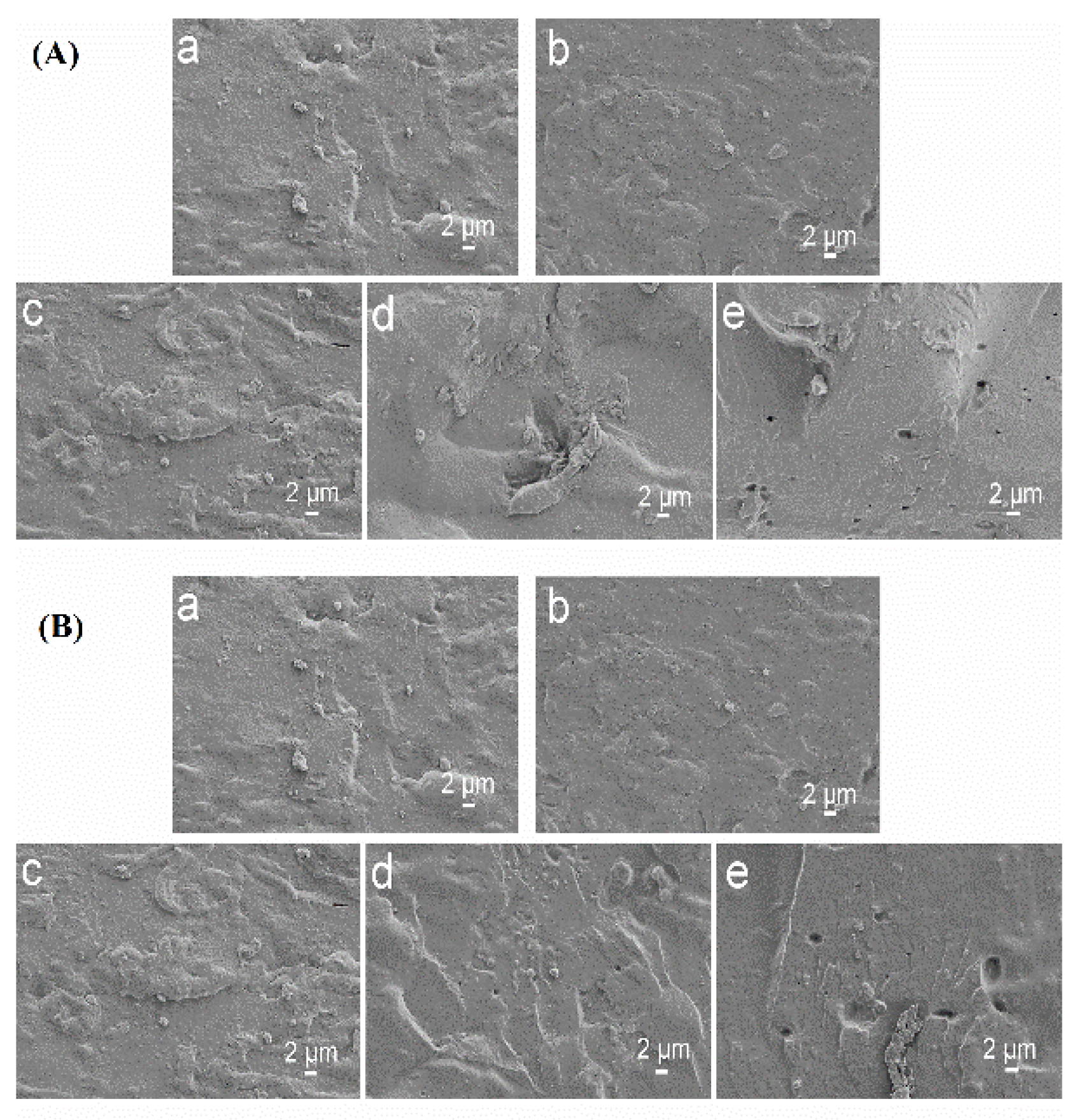
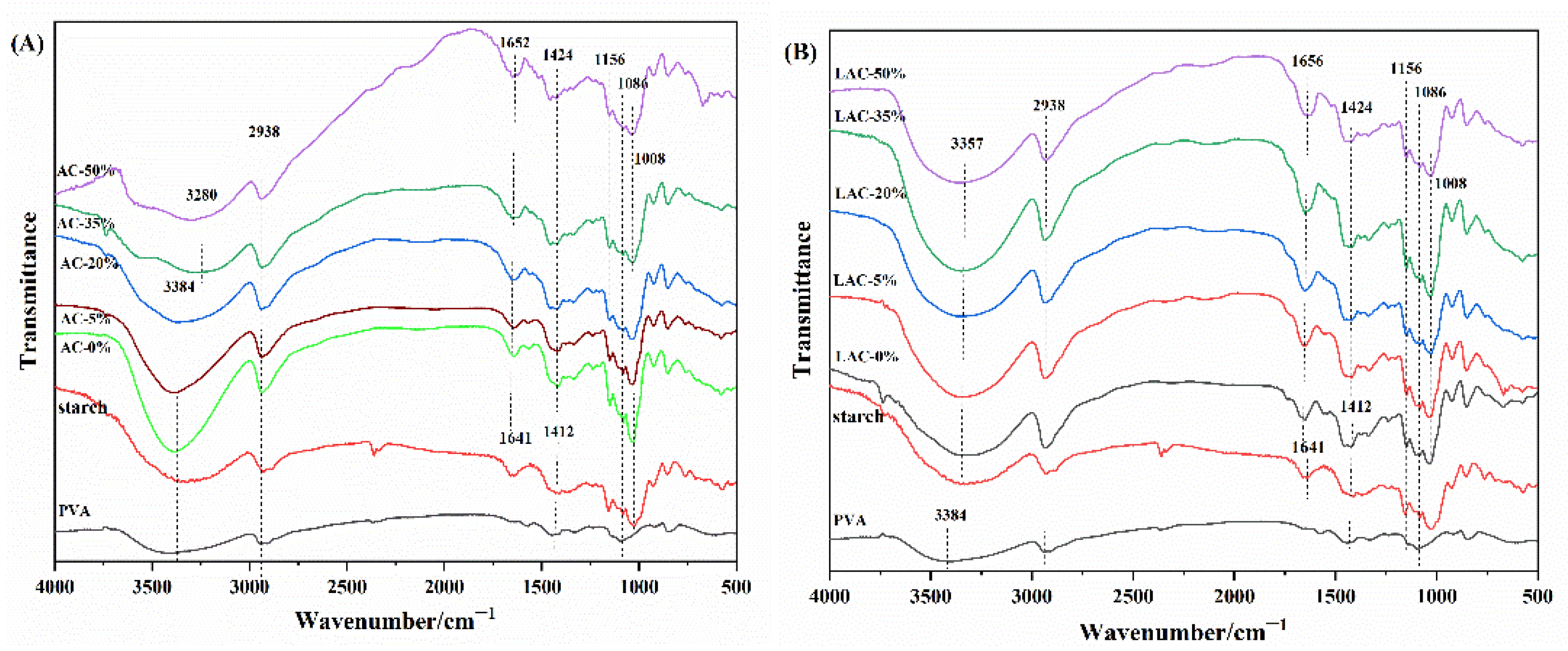
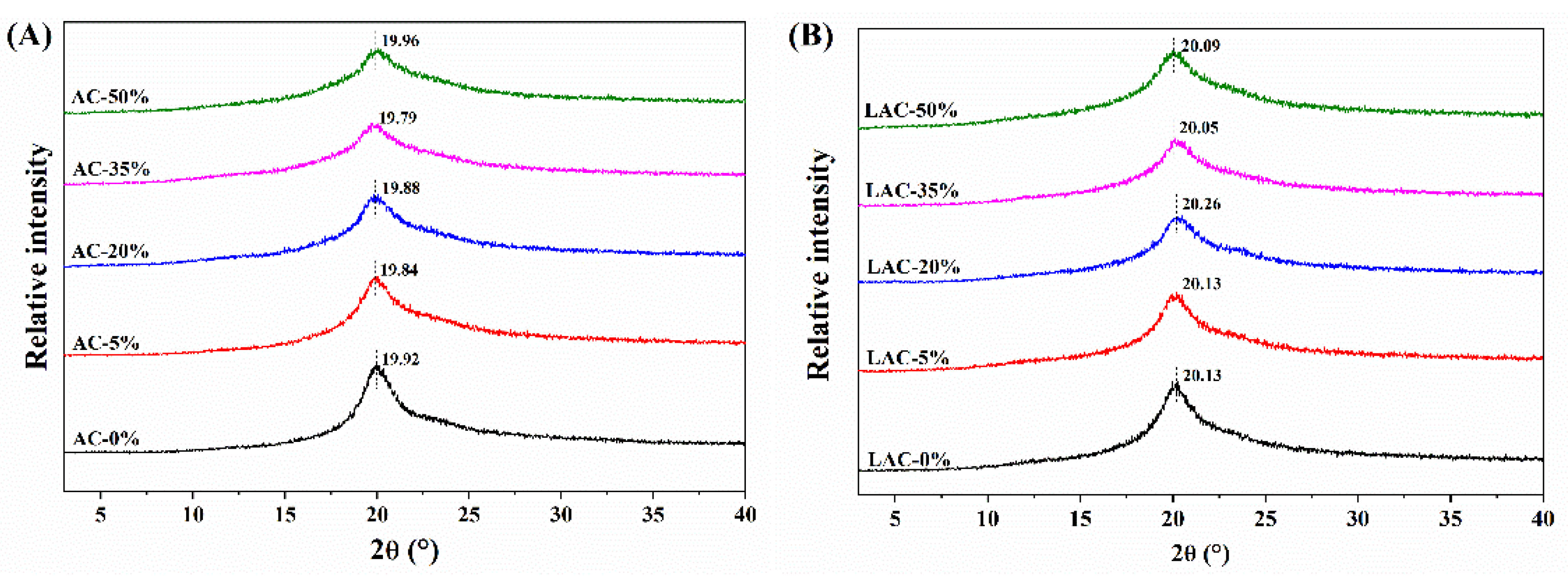
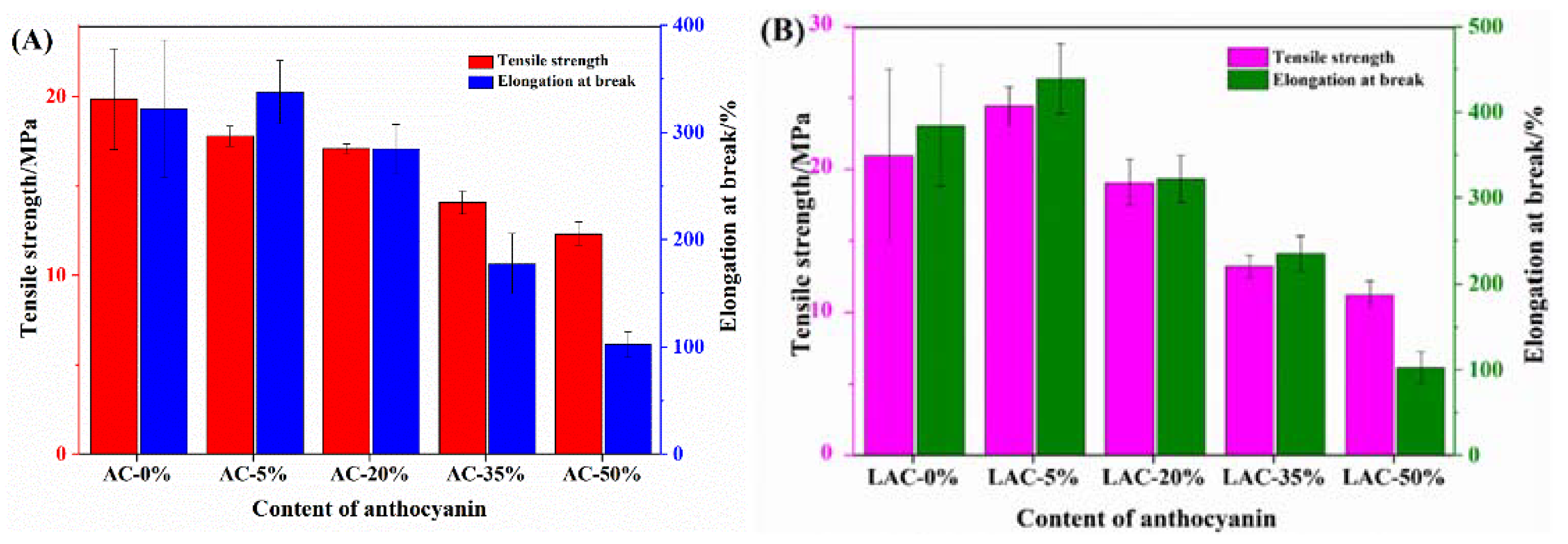
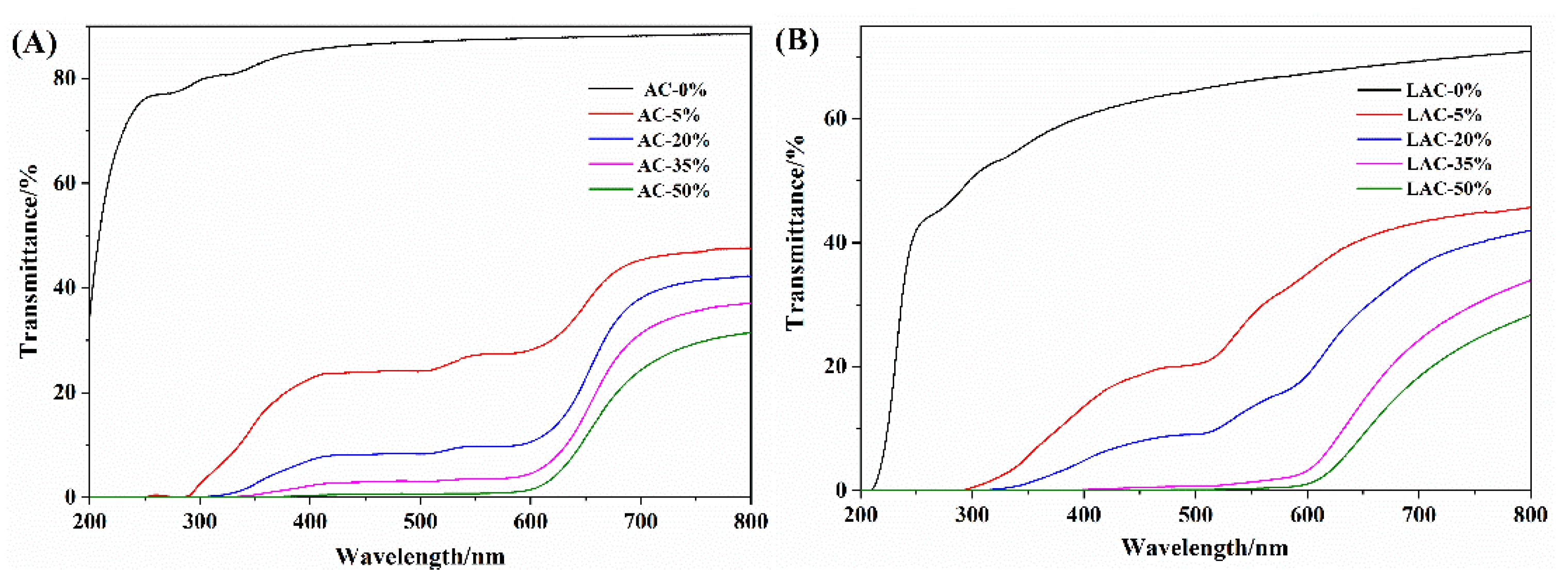
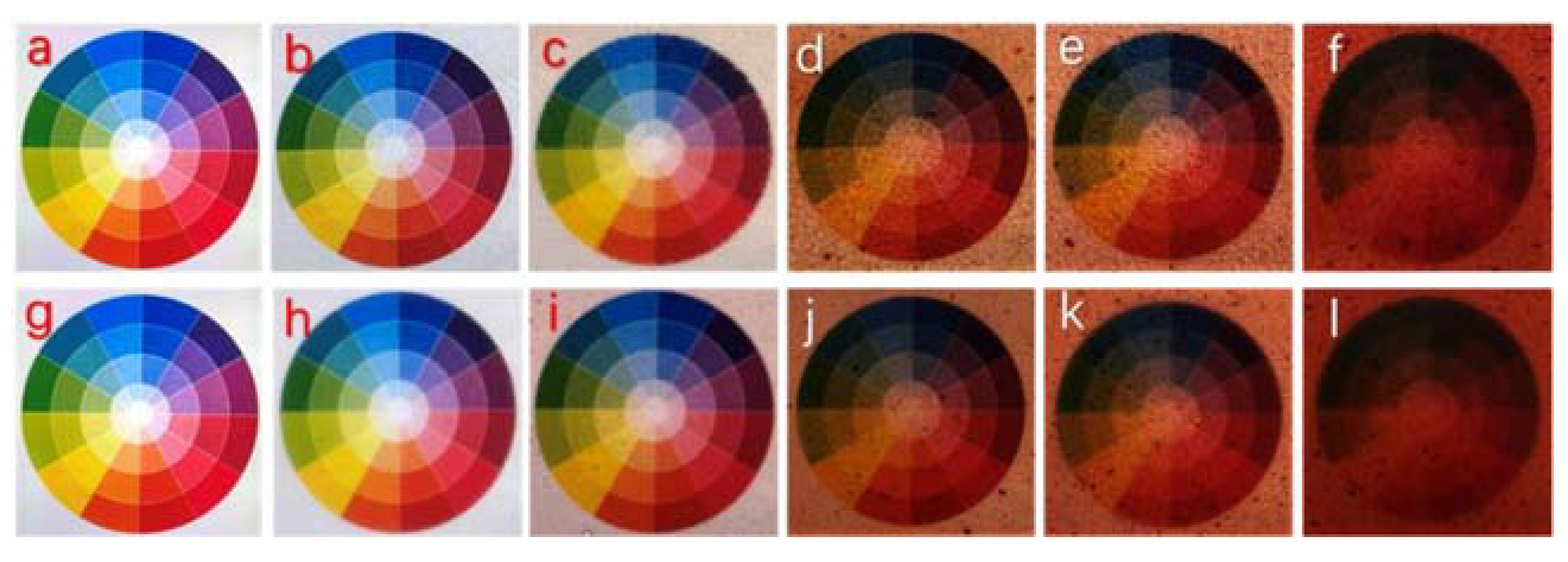
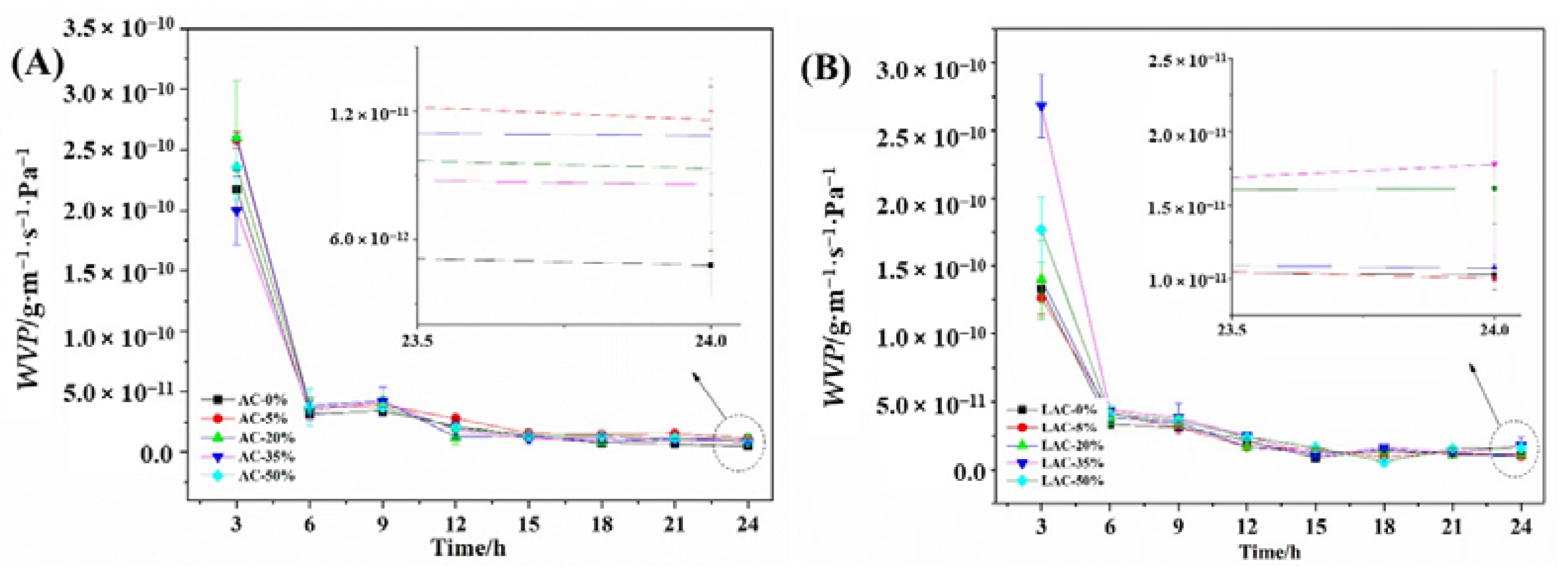

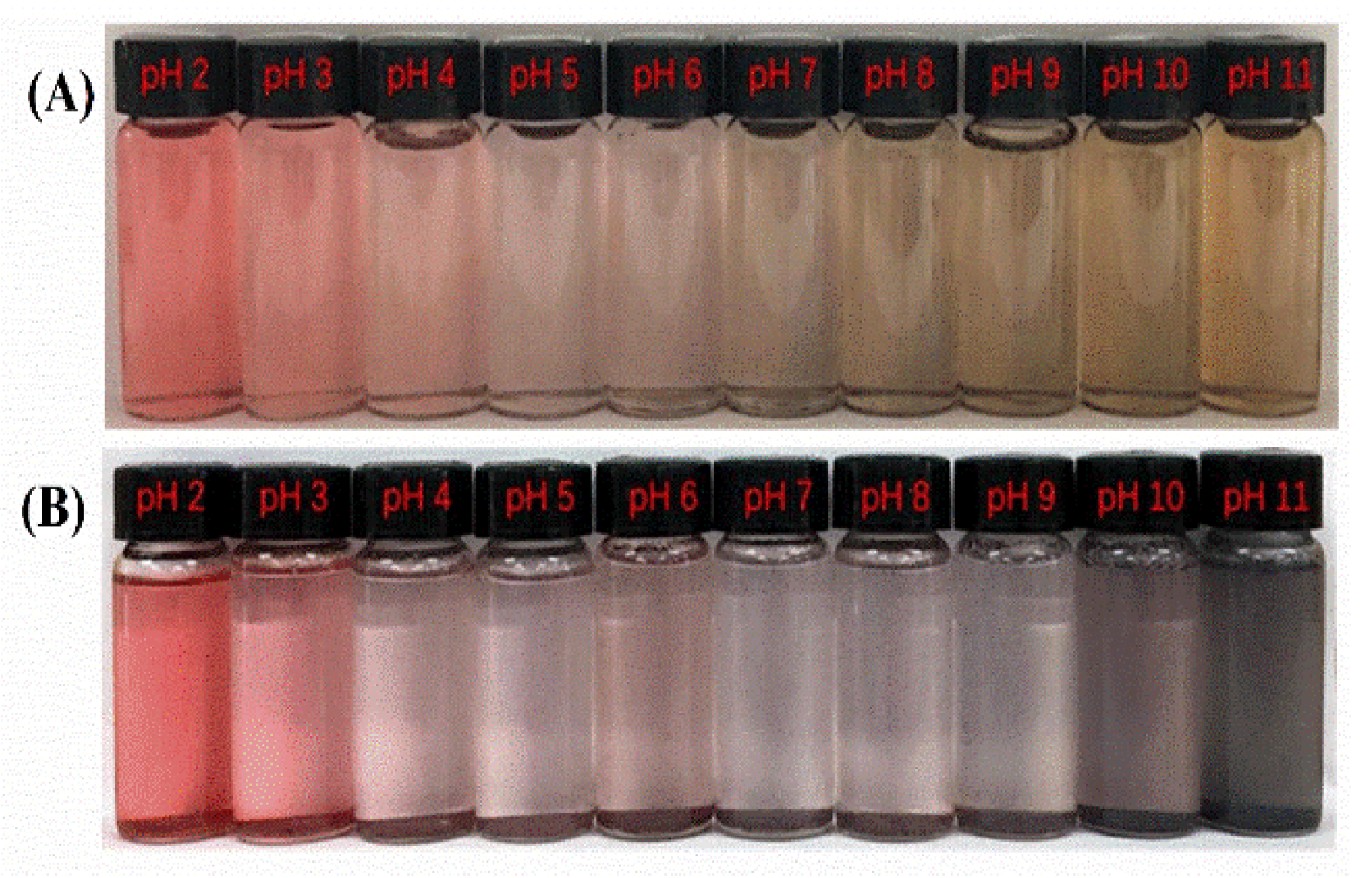
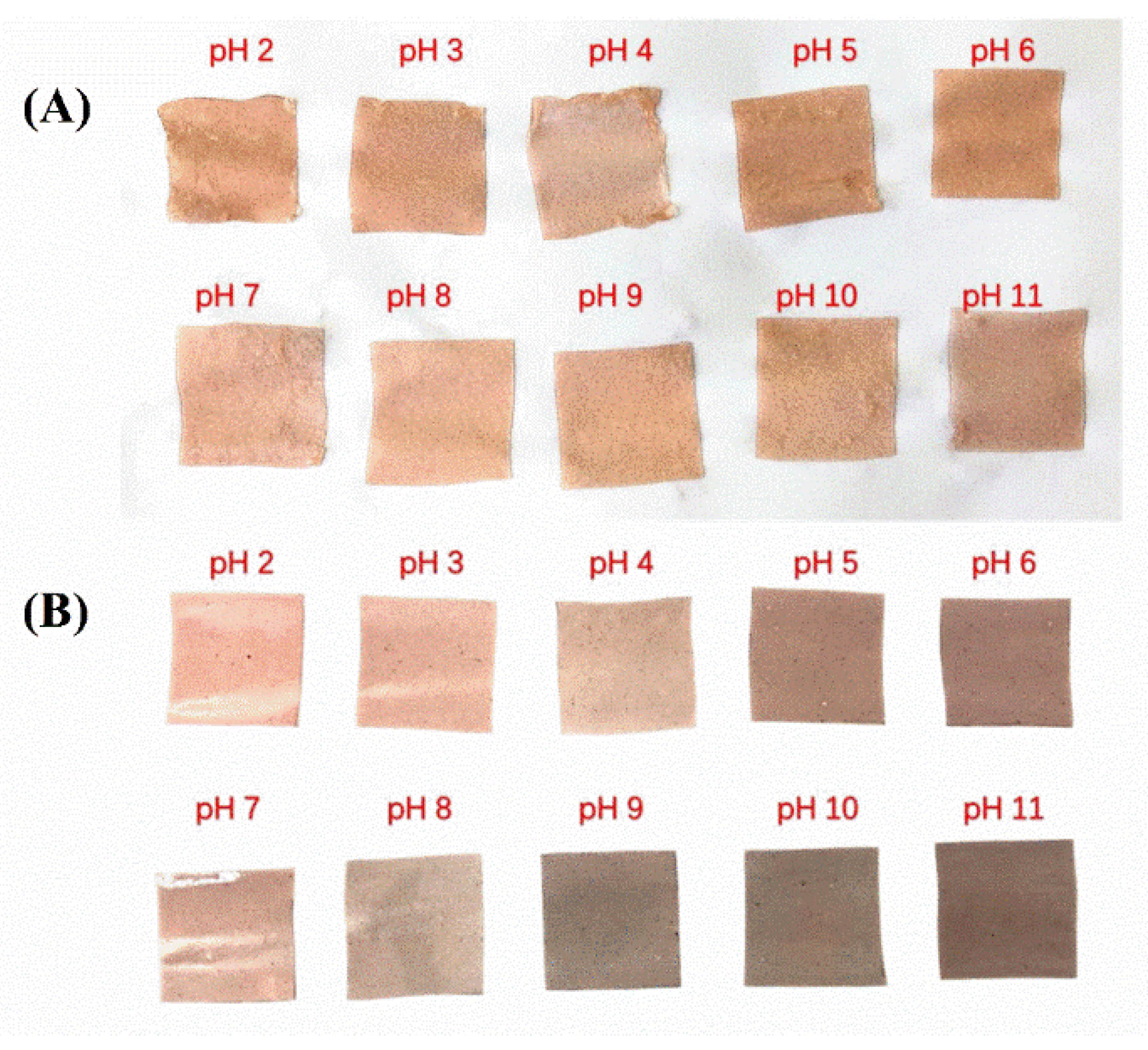

| Film | Anthocyanin Content (%) | Tensile Strength (MPa) | Elongation at Break (%) | Thickness (mm) | Young’s Modulus (MPa) |
|---|---|---|---|---|---|
| 0 | 13.61 ± 0.07 a | 19.86 ± 2.81 a | 0.11 ± 0.004 a | 343.91 ± 44.91 a | |
| 5 | 10.87 ± 0.84 b | 17.78 ± 0.56 a | 0.13 ± 0.002 b | 312.63 ± 31.74 ab | |
| AC | 20 | 11.37 ± 0.46 b | 17.08 ± 0.27 a | 0.13 ± 0.002 b | 292.41 ± 29.53 ab |
| 35 | 9.63 ± 0.46 b | 14.07 ± 0.64 b | 0.15 ± 0.003 c | 233.99 ± 18.62 c | |
| 50 | 10.27 ± 0.16 b | 12.31 ± 0.68 b | 0.16 ± 0.004 d | 163.75 ± 20.19 d | |
| 0 | 11.39 ± 0.14 | 20.95 ± 6.03 a | 0.10 ± 0.014 a | 324.78 ± 31.45 a | |
| 5 | 11.51 ± 1.18 | 24.43 ± 1.34 a | 0.11 ± 0.006 a | 337.84 ± 35.17 a | |
| LAC | 20 | 11.23 ± 1.64 | 19.04 ± 1.63 ab | 0.12 ± 0.003 a | 295.81 ± 30.11 ab |
| 35 | 10.55 ± 0.18 | 13.21 ± 0.78 bc | 0.14 ± 0.005 b | 217.19 ± 20.75 c | |
| 50 | 10.48 ± 0.43 | 11.25 ± 0.93 d | 0.18 ± 0.015 c | 178.25 ± 18.18 d |
| Film | Anthocyanin Content (%) | Opacity | MA (%) | WVP (g·m−1·s−1·Pa−1) |
|---|---|---|---|---|
| 0 | 0.51 ± 0.03 a | 16.00 ± 1.31 | 4.79 × 10−12 ± 1.51 × 10−12 | |
| 5 | 4.30 ± 0.54 b | 18.42 ± 3.72 | 1.16 × 10−11 ± 4.30 × 10−13 | |
| AC | 20 | 7.28 ± 0.45 c | 18.60 ± 3.29 | 1.08 × 10−11 ± 2.70 × 10−12 |
| 35 | 8.95 ± 0.56 c | 19.44 ± 1.96 | 8.55 × 10−12 ± 5.04 × 10−13 | |
| 50 | 11.19 ± 0.59 d | 20.51 ± 1.81 | 9.29 × 10−12 ± 3.83 × 10−12 | |
| 0 | 1.67 ± 0.39 a | 14.81 ± 2.62 | 1.03 × 10−11 ± 6.92 × 10−13 | |
| 5 | 4.11 ± 0.79 a | 15.79 ± 0.30 | 1.00 × 10−11 ± 7.46 × 10−13 | |
| LAC | 20 | 6.13 ± 0.62 b | 15.79 ± 0.77 | 1.07 × 10−11 ± 8.00 × 10−13 |
| 35 | 10.34 ± 0.68 c | 15.91 ± 0.37 | 1.78 × 10−11 ± 6.29 × 10−12 | |
| 50 | 11.01 ± 0.66 c | 17.65 ± 0.10 | 1.62 × 10−11 ± 2.41 × 10−12 |
| Film | Anthocyanin Content (%) | Inhibition Zone of E. coli (mm) | Inhibition Zone of S. aureus (mm) |
|---|---|---|---|
| 0 | 0 | 0 | |
| 5 | 0 | 0 | |
| AC film | 20 | 0 | 0 |
| 35 | 0 | 0 | |
| 50 | 0 | 0 | |
| 0 | 20.65 ± 0.21 a | 37.30 ± 0.28 a | |
| 5 | 12.40 ± 0.35 b | 33.55 ± 0.71 b | |
| LAC film | 20 | 11.55 ± 0.21 b | 22.10 ± 0.21 c |
| 35 | 10.20 ± 0.25 c | 16.45 ± 0.04 d | |
| 50 | 9.70 ± 0.39 c | 16.25 ± 0.11 d |
Publisher’s Note: MDPI stays neutral with regard to jurisdictional claims in published maps and institutional affiliations. |
© 2022 by the authors. Licensee MDPI, Basel, Switzerland. This article is an open access article distributed under the terms and conditions of the Creative Commons Attribution (CC BY) license (https://creativecommons.org/licenses/by/4.0/).
Share and Cite
Li, N.; Zhou, Z.; Wu, F.; Lu, Y.; Jiang, D.; Zhong, L.; Xie, F. Development of pH-Indicative and Antimicrobial Films Based on Polyvinyl Alcohol/Starch Incorporated with Ethyl Lauroyl Arginate and Mulberry Anthocyanin for Active Packaging. Coatings 2022, 12, 1392. https://doi.org/10.3390/coatings12101392
Li N, Zhou Z, Wu F, Lu Y, Jiang D, Zhong L, Xie F. Development of pH-Indicative and Antimicrobial Films Based on Polyvinyl Alcohol/Starch Incorporated with Ethyl Lauroyl Arginate and Mulberry Anthocyanin for Active Packaging. Coatings. 2022; 12(10):1392. https://doi.org/10.3390/coatings12101392
Chicago/Turabian StyleLi, Nannan, Zeguang Zhou, Fuqi Wu, Yanyue Lu, Dongyang Jiang, Lei Zhong, and Fengwei Xie. 2022. "Development of pH-Indicative and Antimicrobial Films Based on Polyvinyl Alcohol/Starch Incorporated with Ethyl Lauroyl Arginate and Mulberry Anthocyanin for Active Packaging" Coatings 12, no. 10: 1392. https://doi.org/10.3390/coatings12101392
APA StyleLi, N., Zhou, Z., Wu, F., Lu, Y., Jiang, D., Zhong, L., & Xie, F. (2022). Development of pH-Indicative and Antimicrobial Films Based on Polyvinyl Alcohol/Starch Incorporated with Ethyl Lauroyl Arginate and Mulberry Anthocyanin for Active Packaging. Coatings, 12(10), 1392. https://doi.org/10.3390/coatings12101392







